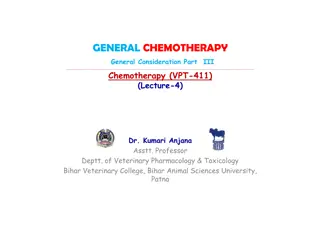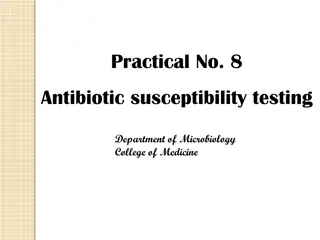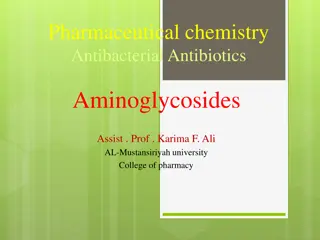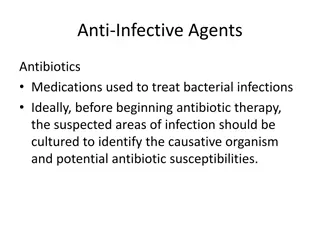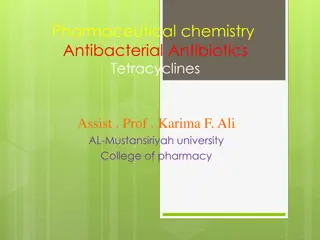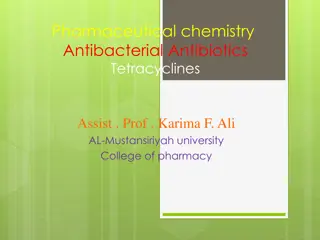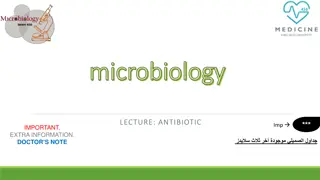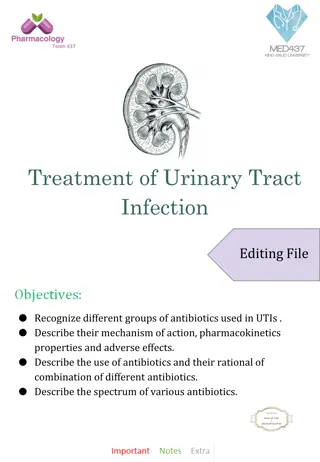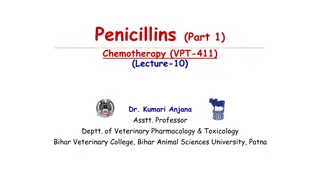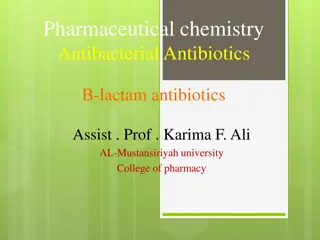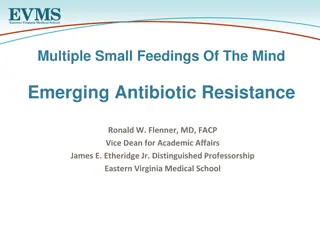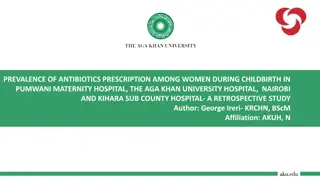Understanding Beta-Lactam Antibiotics in Pharmaceutical Chemistry
Antibiotics, particularly beta-lactam antibiotics, play a vital role in combating bacterial infections. This article explores the definition, classification, and mechanism of action of antibiotics. It delves into the structural features of penicillins, emphasizing the importance of the beta-lactam ring in their antibacterial activity. The evolution from natural to synthetic derivatives is also discussed, highlighting the contributions of medicinal chemists in modifying antibiotics. Overall, it provides insights into the advancements in pharmaceutical chemistry related to antibacterial agents.
Download Presentation

Please find below an Image/Link to download the presentation.
The content on the website is provided AS IS for your information and personal use only. It may not be sold, licensed, or shared on other websites without obtaining consent from the author. Download presentation by click this link. If you encounter any issues during the download, it is possible that the publisher has removed the file from their server.
E N D
Presentation Transcript
Pharmaceutical chemistry Antibacterial Antibiotics -lactam antibiotics Assist . Prof . Karima F. Ali AL-Mustansiriyah university College of pharmacy
Introduction In 1942, Waksman proposed the widely cited definition that an antibiotic or antibiotic substance is a substance produced by microorganisms, which has the capacity of inhibiting the growth and even of destroying other microorganisms. Later proposal shave sought both to expand and to restrict the definition to include any substance produced by a living organism that is capable of inhibiting the growth or survival of one or more species of microorganisms in low concentrations.
The advances made by medicinal chemists to modify naturally occurring antibiotics and to prepare synthetic analogs necessitated the inclusion of semisynthetic and synthetic derivatives in the definition. Therefore, a substance is classified as an antibiotic if the following conditions are met: 1. It is a product of metabolism (although it may be duplicated or even have been anticipated by chemical synthesis). 2. It is a synthetic product produced as a structural analog of a naturally occurring antibiotic.
3. It antagonizes the growth or survival of one or more species of microorganisms. 4. It is effective in low concentrations. Antibiotic: Chemical produced by a microorganism that kills or inhibits the growth of another microorganism Antimicrobial agent: Chemical that kills or inhibits the growth of microorganisms
-lactam antibiotics Antibiotics that possess the -lactam (a four-membered cyclic amide) ring structure are the dominant class of agents currently used for the chemotherapy of bacterial infections. The first antibiotic to be used in therapy, penicillin (penicillin G or benzyl penicillin), and a close biosynthetic relative, phenoxy (penicillin V), remain the agents of choice for the treatment of infections caused by most species of Gram-positive bacteria. methyl penicillin
The key structural feature of the penicillins is the four-membered -lactam ring; this structural moiety is essential for penicillin's antibacterial activity. The - lactam ring is itself fused to a five-membered thiazolidine ring. The fusion of these two rings causes the -lactam ring to be more reactive than monocyclic -lactams because the two fused rings distort the - lactam amide bond and resonance stabilization normally found in these chemical bonds. therefore remove the
Mechanism of Action selective inhibition of bacterial cell wall synthesis. Specifically, the basic inhibition of the biosynthesis of the dipeptidoglycan that provides strength and rigidity to the cell wall. Penicillins and cephalosporins acylate a specific bacterial D-trans peptidase, target the penicillin- binding proteins or PBPs - a group of enzymes found anchored in the cell membrane, which are involved in the cross-linking of the bacterial cell wall. thereby rendering it inactive for its role in forming peptide cross-links of two linear peptidoglycan strands by trans peptidation and loss of D-alanine. mechanism involved is
Mechanism of -Lactam Drugs The amide of the -lactam ring is unusually reactive due to ring strain and a conformational arrangement which does not allow the lone pair of the nitrogen to interact with the double bond of the carbonyl. Because of this fused four five ring system this carbonyl Carbone more partially positive , more ectrophilic and more reactive. So that why -lactam ring easily hydrolyzed. Two factors make -lactam reactive 1. There is not as much resonance stabilization 2. Ring strain
-Lactams acylate the hydroxyl group on the serine residue of PBP active site in an irreversible manner. This reaction is further aided by the oxyanion hole, which stabilizes the tetrahedral intermediate and thereby reduces the transition state energy. -OH act as nucleophile and going to attack carbonyl Carbone which is more electrophilic than the most amide.
Mechanism of -Lactam Drugs The hydroxyl attacks the amide and forms a tetrahedral intermediate.
Mechanism of -Lactam Drugs The tetrahedral intermediate collapses, the amide bond is broken, and the nitrogen is reduced.
Mechanism of -Lactam Drugs The PBP is now covalently bound by the drug and cannot perform the cross linking action.
Bacterial Resistance most species of Gram-negative bacilli, are naturally resistant to the action of penicillins. Other normally sensitive species can develop penicillin resistance (either through natural selection of resistant individuals or through mutation). The most important biochemical penicillin resistance is the bacterial elaboration of enzymes that inactivate penicillins. Such enzymes, which have been given penicillinases, are of two general types: - lactamases and acylases. mechanism of the nonspecific name
By far, the more important of these are the - lactamases, enzymes that catalyze the hydrolytic opening of the -lactam ring of penicillins to produce inactive penicilloic acids. Specific acylases (enzymes that can hydrolyze the acylamino side chain of penicillins) have been obtained from several species of Gram-negative bacteria Another important resistance mechanism, especially in Gram-negative bacteria, is decreased permeability to penicillins. Alteration of the number or nature of porins in the cell envelope also could be an important mechanism of antibiotic resistance
The penicillins Several closely related compounds produced. These compounds differ chemically in the acid moiety of the amide side chain. Variations in this moiety produce differences in antibiotic effect and in physicochemical properties, including stability.
Nomenclature The Chemical Abstracts system initiates the numbering with the sulfur atom and assigns the ring nitrogen the 4- position. Thus, penicillins are named as 4-thia-l- azabicycloheptanes, according to this system. The numbering system adopted by the USP is the reverse of the Chemical Abstracts procedure, assigning number 1 to the nitrogen atom and number 4 to the sulfur atom. The name penam used for the unsubstituted bicyclic system, including the amide carbonyl group, with one of the foregoing numbering systems
Thus, penicillins generally are designated according to the Chemical Abstracts system as 5- acylamino-2,2- dimethylpenam-3-carboxylic Uses the name penicillanic acid to describe the ring system with substituents that are generally present (i.e., 2,2-dimethyl and 3-carboxyl).
Stereochemistry The penicillin molecule contains three chiral carbon atoms (C-3, C-5, and C-6). All naturally occurring and microbiologically semisynthetic penicillins have the same absolute configuration about these three centers. The carbon atom bearing the acylamino group (C-6) has the L configuration, whereas the carbon to which the carboxyl group is configuration. Thus, the acylamino and carboxyl groups are trans to each other, with the former in the and the latter in the orientation relative to the penam ring system. active synthetic and attached has the D
The atoms composing the 6-aminopenicillanic acid (6- APA) portion of the structure are derived biosynthetically from two amino acids, L-cysteine (S-1, C-5, C-6, C-7, and 6-amino) and L-valine (2,2-dimethyl, C-2, C-3, N-4, and 3- carboxyl). The absolute stereochemistry designated 3S:5R:6R of the penicillins is
Modification of -Lactams -Lactam type antibiotics can be modified at various positions to improve their ability to: -be administered orally (survive acidic conditions) -be tolerated by the patient (allergies) -penetrate the outer membrane of Gram (-) bacteria -prevent hydrolysis by -lactamases -acylate the PBPs of resistant species (there are many different PBPs)
penicillins- natural Natural penicillins are those which can be obtained directly from the penicillium mold and do not require further modification. Many species of bacteria are now resistant to these penicillins. Penicillin G not orally active
Penicillin V Penicillin V is produced when phenoxyacetic acid rather than phenylacetic acid is introduced to the penicillium culture. Adding the oxygen decreases the nucleophilicity of the carbonyl group, making penicillin V acid stable and orally viable.
Production All commercially available -lactams are initially produced through the fermentation of bacteria. Bacteria assemble the penicillin molecule from L- AAA, L-valine, and L-cysteine in three steps using ACV synthase, IPN synthase, and acyl transferase.
Chemical Degradation 1. The solubility and other physicochemical properties of the penicillins are affected by the nature of the acyl side chain and by the cations used to make salts of the acid. Most penicillins are acids with pKa values in the range of 2.5 to 3.0, but some are amphoteric. 2. The free acids are not suitable for oral or parenteral administration. The sodium and potassium salts of most penicillins, however, are soluble in water and readily absorbed orally or parenterally.
3. -lactam carbonyl group of penicillin readily undergoes nucleophilic attack by water or (especially) hydroxide ion to form the inactive penicilloic acid, which is reasonably stable in neutral to alkaline solutions but readily undergoes decarboxylation and further hydrolytic reactions in acidic solutions. 4. Other nucleophiles, such as hydroxylamines, alkylamines, and alcohols, open the -lactam ring to form the corresponding hydroxamic acids, amides, and esters. It has been speculated that one of the causes of penicillin allergy may be the formation of antigenic penicilloyl proteins in vivo by the reaction of
nucleophilic groups (e.g., -amino) on specific body proteins with the -lactam carbonyl group. 5. In strongly acidic solutions (pH 3), penicillin undergoes a complex series of reactions leading to various inactive degradation products .The first step appears to involve rearrangement to the penicillanic acid. This process is initiated by protonation of the - lactam nitrogen, followed by nucleophilic attack of the acyl oxygen atom on the -lactam carbonyl carbon. The subsequent opening of the -lactam ring destabilizes the thiazoline ring, which then also suffers acid- catalyzed ring opening to form the penicillanic acid.
Penicillin G in acidic conditions Penicillin G could not be administered orally due to the acidic conditions of the stomach.
Acid-catalyzed degradation In the stomach contributes strongly to the poor oral absorption of penicillin. penicillins with improved microbiological properties have focused on acyl functionalities that would minimize sensitivity of the -lactam ring to acid hydrolysis while maintaining antibacterial activity. Substitution of an electron-withdrawing group in the - position of benzylpenicillin markedly stabilizes the penicillin to acid-catalyzed hydrolysis. Thus, efforts to obtain pharmacokinetic and
Semi-Synthetic Penicillins The acyl side chain of the penicillin molecule can be cleaved using enzyme or chemical methods to produce 6-APA, which can further be used to produce semi- synthetic penicillins or cephalosporins 75% of the penicillin produced is modified in this manner
Penicillins- Anti staphylococcal Penicillins which have bulky side groups can block the -Lactamases which hydrolyze the lactam ring.
Methicillin Methicillin was the first penicillin developed with this type of modification, Methicillin sodium is particularly resistant to penicillinase found in staphylococci and somewhat more resistant than penicillin G to penicillinase from Bacillus cereus. The absence of the benzyl methylene group of penicillin G and the steric protection afforded by the 2- and 6-methoxy groups make this compound particularly resistant to enzymatic hydrolysis. inactivation by the
Methicillin is acid sensitive and has been improved upon by adding electron withdrawing groups, as was done in penicillin V, resulting in drugs such as oxacillin and nafcillin. In oxacillin the steric effects of the 3-phenyl and 5-methyl groups of the isoxazolyl ring prevent the binding of this penicillin to the -lactamase active site and, thereby, protect the lactam ring from degradation in much the same way as has been suggested for methicillin. It is also relatively resistant to acid hydrolysis and, therefore, may be administered orally with good effect.
The substitution of chlorine atoms on ortho or on both carbons ortho to the position of attachment of the phenyl ring to the isoxazole ring enhances the activity and the stability of Cloxacillin , enhancing its oral absorption, leading to higher plasma levels. Nafcillin sodium, 6-(2-ethoxy-1-naphthyl)penicillin sodium (Unipen), is another semisynthetic penicillin that resulted from the search compounds. Like methicillin, nafcillin has substituents in positions ortho to the point of attachment of the aromatic ring to the carboxamide group of penicillin. No doubt, the ethoxy group and the second ring of the naphthalene group play steric roles in stabilizing nafcillin against penicillinase Dicloxacillin sodium, by for penicillinase-resistant
Oxacillin Sodium Methicillin Sodium Dicloxacillin Sodium Cloxacillin sodium Nafcillin Sodium
Penicillins- Amino penicillins In order to increase the range of activity, the penicillin has been modified to have more hydrophilic groups, allowing the drug to penetrate into Gram (-) bacteria via the porins. Ampicillin R=Phenyl Amoxicillin R= Phenyl -OH
Ampicillin 6-[D- -amino phenyl acetamido]penicillanic acid, D- -amino benzyl penicillin an antibacterial spectrum broader than that of penicillin G. Obviously, the - amino group plays an important role in the broader activity, but the mechanism for its action is unknown. It has been suggested that the amino group confers an ability to cross cell wall barriers that are impenetrable to other penicillins. D-(-)-Ampicillin, prepared phenylacetic acid, is significantly more active than L- (+)-ampicillin. from D-(-)- -amino
Ampicillin is not resistant to penicillinase, and it produces the allergic reactions Ampicillin is water soluble and stable in acid. The protonated -amino group of ampicillin has a pKa of 7.3 and thus it is protonated extensively in acidic media, which explains ampicillin s stability to acid hydrolysis and instability to alkaline hydrolysis. Ampicillin
Amoxicillin is simply the p-hydroxy analog of ampicillin, prepared by acylation of 6-APA with p-hydroxy phenyl glycine. Its antibacterial spectrum is nearly identical with that of ampicillin, and like ampicillin, it is resistant to acid, susceptible to alkaline and -lactamase hydrolysis, and weakly protein bound. Early clinical reports indicated that orally administered significant advantages over ampicillin, including more complete GI absorption amoxicillin possesses
-lactamase inhibitors The discovery of the naturally occurring, mechanism based inhibitor Clavulanic acid, which causes potent and progressive inactivation of -lactamases has created renewed interest in -lactam combination therapy. This interest has led to the design and synthesis of additional mechanism-based -lactamase inhibitors, such as sulbactam and tazobactam, and the isolation of naturally occurring -lactams, Thienamycins, which both inhibit -lactamases and interact with PBPs. such as the
Clavulanate Potassium Clavulanic acid is an antibiotic isolated from Streptomyces clavuligeris. Structurally, it is a 1- oxopenam lacking the 6-acylamino side chain of penicillins but possessing a 2- hydroxyethylidene moiety at C-2. Clavulanic acid exhibits very weak antibacterial activity, comparable with that of 6- APA and, therefore, is not useful as an antibiotic. It is, however, a potent inhibitor of S. aureus - lactamase and plasmid-mediated elaborated by Gram negative bacilli. -lactamases





